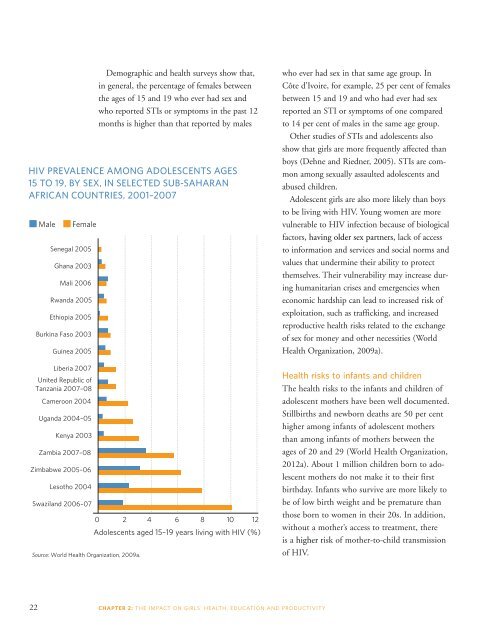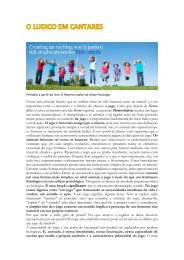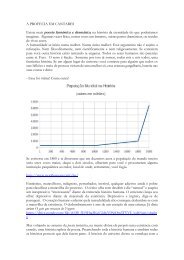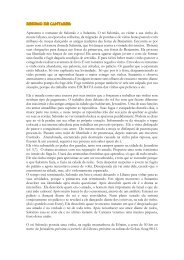Motherhood in Childhood
You also want an ePaper? Increase the reach of your titles
YUMPU automatically turns print PDFs into web optimized ePapers that Google loves.
Demographic and health surveys show that,<br />
<strong>in</strong> general, the percentage of females between<br />
the ages of 15 and 19 who ever had sex and<br />
who reported STIs or symptoms <strong>in</strong> the past 12<br />
months is higher than that reported by males<br />
HIV PREVALENCE AMONG ADOLESCENTS AGES<br />
15 TO 19, BY SEX, IN SELECTED SUB-SAHARAN<br />
AFRICAN COUNTRIES, 2001–2007<br />
Male<br />
Female<br />
Senegal 2005<br />
Ghana 2003<br />
Mali 2006<br />
Rwanda 2005<br />
Ethiopia 2005<br />
Burk<strong>in</strong>a Faso 2003<br />
Gu<strong>in</strong>ea 2005<br />
Liberia 2007<br />
United Republic of<br />
Tanzania 2007–08<br />
Cameroon 2004<br />
Uganda 2004–05<br />
Kenya 2003<br />
Zambia 2007–08<br />
Zimbabwe 2005–06<br />
Lesotho 2004<br />
Swaziland 2006–07<br />
Source: World Health Organization, 2009a.<br />
0<br />
2<br />
4<br />
6<br />
Adolescents aged 15–19 years liv<strong>in</strong>g with HIV (%)<br />
8<br />
10<br />
12<br />
who ever had sex <strong>in</strong> that same age group. In<br />
Côte d’Ivoire, for example, 25 per cent of females<br />
between 15 and 19 and who had ever had sex<br />
reported an STI or symptoms of one compared<br />
to 14 per cent of males <strong>in</strong> the same age group.<br />
Other studies of STIs and adolescents also<br />
show that girls are more frequently affected than<br />
boys (Dehne and Riedner, 2005). STIs are common<br />
among sexually assaulted adolescents and<br />
abused children.<br />
Adolescent girls are also more likely than boys<br />
to be liv<strong>in</strong>g with HIV. Young women are more<br />
vulnerable to HIV <strong>in</strong>fection because of biological<br />
factors, hav<strong>in</strong>g older sex partners, lack of access<br />
to <strong>in</strong>formation and services and social norms and<br />
values that underm<strong>in</strong>e their ability to protect<br />
themselves. Their vulnerability may <strong>in</strong>crease dur<strong>in</strong>g<br />
humanitarian crises and emergencies when<br />
economic hardship can lead to <strong>in</strong>creased risk of<br />
exploitation, such as traffick<strong>in</strong>g, and <strong>in</strong>creased<br />
reproductive health risks related to the exchange<br />
of sex for money and other necessities (World<br />
Health Organization, 2009a).<br />
Health risks to <strong>in</strong>fants and children<br />
The health risks to the <strong>in</strong>fants and children of<br />
adolescent mothers have been well documented.<br />
Stillbirths and newborn deaths are 50 per cent<br />
higher among <strong>in</strong>fants of adolescent mothers<br />
than among <strong>in</strong>fants of mothers between the<br />
ages of 20 and 29 (World Health Organization,<br />
2012a). About 1 million children born to adolescent<br />
mothers do not make it to their first<br />
birthday. Infants who survive are more likely to<br />
be of low birth weight and be premature than<br />
those born to women <strong>in</strong> their 20s. In addition,<br />
without a mother’s access to treatment, there<br />
is a higher risk of mother-to-child transmission<br />
of HIV.<br />
22 CHAPTER 2: THE IMPACT ON GIRLS' HEALTH, EDUCATION AND PRODUCTIVITY

















